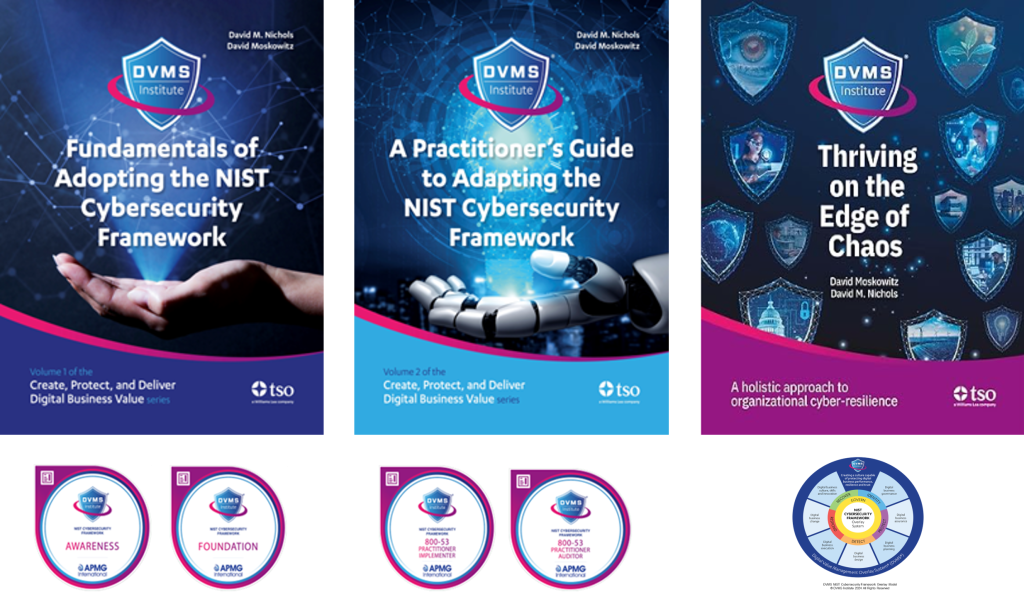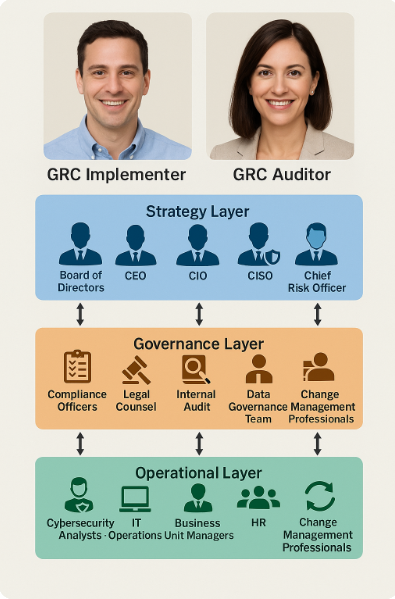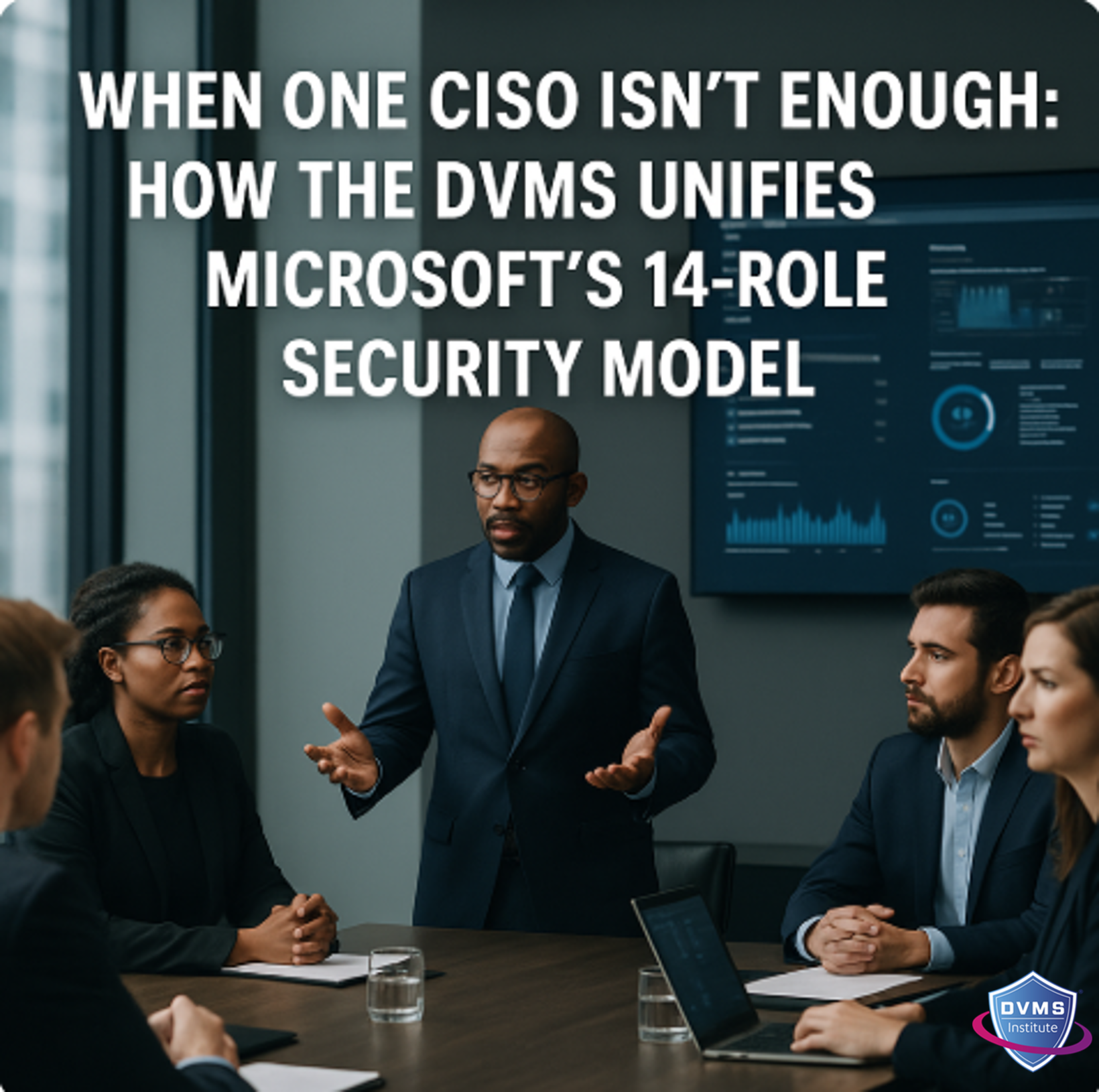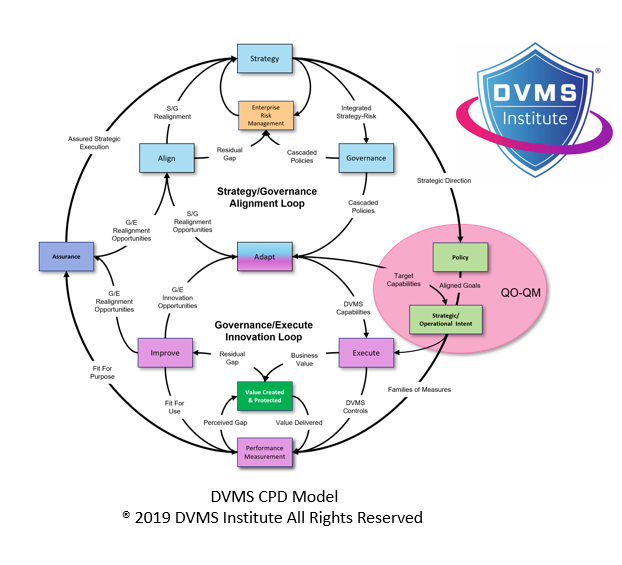GRC Professionals at Work – Mentoring Enterprise Teams for NIST-CSF-DVMS Integration and Success
Rick Lemieux – Co-Founder and Chief Product Officer of the DVMS Institute
Two of the most critical roles are the GRC (Governance, Risk, and Compliance) Implementer and the GRC Auditor. They are responsible for ensuring the NIST-CSF-DVMS program is fit for use within the organization and its supply chain and fit for purpose regarding regulatory outcomes.
Contextualizing the NIST-CSF-DVMS Ecosystem
Before diving into the specific contributions of the GRC Implementer and Auditor, it’s crucial to understand the broader organizational context. The NIST CSF offers a flexible framework organized around five core functions—Identify, Protect, Detect, Respond, and Recover—that define desired cybersecurity outcomes. The DVMS overlays this framework with a systems-thinking approach, articulated through the CPD Model (Create, Protect, Deliver), the Z-X Capability Model (Govern, Assure, Plan, Design, Execute, Change, Innovate) and the 3D Knowledge Model (Dynamic governance through cross-silo communication and collaboration). These models require collaboration across the enterprise’s strategy, governance, and operational layers.
Each layer houses distinct responsibilities. Strategic leaders like CEOs and CISOs define risk-informed direction. Governance teams translate strategy into enforceable policies and controls. Operational teams implement and maintain secure business practices. Within and across these layers, GRC Implementers and Auditors play pivotal roles in facilitating alignment, enforcing accountability, and driving continuous improvement.
The GRC Implementer: The Integration Specialist
The GRC Implementer is the frontline enabler of DVMS-CSF adoption. Acting as a systems integrator, this role connects policies to practice, aligning intent with implementation. They work closely with stakeholders across all enterprise layers to embed CSF and DVMS principles into day-to-day operations.
- Translating Frameworks into Workflows
GRC Implementers interpret the abstract language of the NIST CSF and DVMS into concrete, actionable practices that can be embedded into business processes. They work with business process owners, IT teams, HR, and other operational stakeholders to ensure cybersecurity requirements are documented and lived out in standard operating procedures.
For example, when integrating the CSF’s “Protect” function, the GRC Implementer ensures that access control policies are reflected in how identity management systems are configured, HR handles onboarding/offboarding, and access audits are executed.
- Driving Continuous Improvement
The GRC Implementer supports the organizational progression through the DVMS FastTrack phases—Initiate, Basic Hygiene, Expand, and Innovate. They monitor implementation progress, identify bottlenecks, and coordinate change management across departments. Their iterative efforts support the “Change” and “Innovate” capabilities of the Z-X Model.
This role is especially critical when organizations adapt to new regulations or threats. By assessing the current posture, designing improvement plans, and facilitating execution, the Implementer helps organizations close maturity gaps and operationalize resilience.
- Enabling Cross-Functional Alignment
DVMS implementation demands legal compliance, operations, cybersecurity, and coordination of executive functions. The GRC Implementer serves as a translator and mediator between these domains. For instance, they may work with Legal and Compliance to ensure that policies meet GDPR or HIPAA requirements, then guide IT and operations teams in applying those policies in systems and practices.
They also liaise with the CISO, and governance leads to align implementation plans with board-mandated risk thresholds and performance metrics. Their presence ensures that strategy, policy, and execution remain tightly interwoven.
- Empowering Culture and Behavior Change
Adopting the CSF-DVMS approach is as much about cultural transformation as technical or procedural alignment. GRC Implementers work closely with HR to design awareness programs and behavioral expectations that reinforce secure and accountable behavior across the enterprise. These programs help cultivate a security-conscious culture that aligns with the CSF’s Protect and Detect functions.
The GRC Auditor: The Assurance Backbone
While the GRC Implementer focuses on adoption and integration, the GRC Auditor provides the independent assurance that these systems function as intended. They verify that the practices implemented under the CSF and DVMS are consistent, effective, and compliant.
- Validating Controls and Conformance
GRC Auditors assess whether cybersecurity controls are appropriately designed, implemented, and maintained. They examine logs, configurations, workflows, and evidence to ensure that organizational practices reflect the controls documented in policies. This assurance is crucial to the “Assure” capability in the DVMS model and directly supports the CSF’s tiered approach to maturity and measurement.
Through control validation, the Auditor helps define the Current Profile under the CSF and identifies any deviation from the desired Target Profile. This gap analysis feeds back into the planning and improvement activities spearheaded by the GRC Implementer.
- Enabling Informed Risk Decisions
GRC Auditors arm senior leaders and risk owners with the information necessary to make informed decisions by providing an objective view of current-state operations. They spotlight residual risks, highlight systemic issues, and recommend risk-prioritized remediation plans. In doing so, they act as trusted advisors to the Chief Risk Officer (CRO), CISO, and the board.
- Supporting Regulatory and Legal Compliance
Auditors ensure that the organizational cybersecurity practices meet external obligations—whether these are legal (e.g., HIPAA, GDPR), regulatory (e.g., SEC, DORA), or industry-specific (e.g., HITRUST, CMMC). They review whether CSF-DVMS alignment has resulted in verifiable compliance artifacts. Their findings reduce the risk of fines, sanctions, or reputational damage.
- Enhancing Organizational Learning
An effective GRC Auditor does more than identify gaps—they promote organizational learning. By feeding insights into incident post-mortems, lessons-learned sessions, and governance reviews, they help teams avoid repeated mistakes and reinforce a cycle of continuous improvement. Their audits also validate the effectiveness of training and awareness efforts, helping HR and business leaders adjust course where needed.
A Symbiotic Relationship: Implementers and Auditors as Dual Engines of Maturity
While distinct in purpose, the GRC implementer and GRC auditor are most effective when they function in tandem. The Implementer brings change to life, while the Auditor ensures that the change is effective and sustainable. The feedback loop between these roles fuels the continuous improvement cycle required for resilient, value-driven cybersecurity.
Together, they support the people and teams that power the NIST-CSF-DVMS program—from strategic executives to frontline engineers, HR trainers, and procurement officers. Designing solutions, verifying compliance, or advising leadership are essential catalysts in an organizational digital trust journey.
Conclusion
In the NIST-CSF-DVMS ecosystem, the GRC Implementer and GRC Auditor are not merely support roles but strategic partners in the enterprise’s ability to create, protect, and deliver digital value. Their work underpins alignment across organizational layers, facilitates cultural change, assures operational integrity, and ensures compliance in a volatile digital landscape.
By empowering the people and teams who drive cybersecurity from vision to execution, these roles are instrumental in delivering compliance, resilience, agility, and sustainable digital performance.
About the Author

Rick Lemieux
Co-Founder and Chief Product Officer of the DVMS Institute
Rick has 40+ years of passion and experience creating solutions to give organizations a competitive edge in their service markets. In 2015, Rick was identified as one of the top five IT Entrepreneurs in the State of Rhode Island by the TECH 10 awards for developing innovative training and mentoring solutions for boards, senior executives, and operational stakeholders.
In today’s digitally driven economy, cyber disruptions are no longer an “if” but a “when.”
The DVMS Institute’s Certified Training Programs teach organizations the skills to build a Holistic and Culture-Aligned Overlay System capable of coordinating Adaptive Cyber Operations Governance, Resilience, and Assurance across a Complex Digital Ecosystem.
Achieving true cyber resilience across a complex digital ecosystem requires seamless alignment between organizational Strategy, Governance, and Operations, underpinned by a culture dedicated to sustaining and continuously innovating organizational digital value.

The DVMS positions cyber resilience as a strategic, enterprise-wide capability powered by the Institute’s CPD, Z-X, and 3D Knowledge models.
This systems-based approach to cyber operational resilience demands active engagement from all members of the Digital Ecosystem, with each member playing a distinct role in proactively identifying and mitigating the systemic risks that threaten digital business operations.
This adaptive, forward-looking approach to Governance, Resilience, and Assurance (GRA) positions businesses to:
- Maintain Operational Stability Amidst Constant Digital Disruption
- Drive Agility and Trust Across Your Digital Ecosystem
- Satisfy Critical Regulatory and Certification Requirements
- Leverage Cyber Resilience as a Competitive Advantage
DVMS Explainer Videos
- Architecture Video: David Moskowitz explains the DVMS System
- Case Study Video: Dr. Joseph Baugh Shares His DVMS Story.
- Overlay Model – What is an Overlay Model
- ZX Model – The MVC’s that power operational resilience
- CPD Model – Adaptable governance and assurance
- 3D Knowledge Model – Enabling holistic organizational learning
- FastTrack Model – A phased approach to cyber resilience
Digital Value Management System® is a registered trademark of the DVMS Institute LLC.
® DVMS Institute 2025 All Rights Reserved




